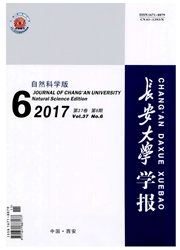

 中文摘要:
中文摘要:
为解决已有可达性研究没有量化可达性与客流需求关系,以及没有考虑实际公交网络中线路首末站布局位置的问题,首先提出广义可达性的概念,引入可达强度指标,并在此基础上建立了已知规划站点布设和规划线路数量,以客流强度与可达强度匹配最佳和可达性值最大为目标,以首末站布局位置要求为约束的公交线网可达性优化模型,设计了求解该模型的遗传算法,并通过算例对模型和算法进行验证。研究结果表明:考虑量化可达性与客流关系及首末站约束条件后的公交线网优化方案,其可达强度与客流强度匹配程度比不考虑上述条件的公交线网优化方案提高了1.57%,且最终优化方案满足首末站布局位置约束条件;在公交线网设计及优化时,考虑可达性与客流关系能够有效提高线网布局与客流出行需求的匹配程度,使线网中的直达出行比例提高,乘客出行更为便捷;依据公交线网规划与优化过程中首末站点应布设在公交场站内或靠近公交场的实际情况,增加首末站点布局约束条件可使最终优化线网与实际相符。研究为公交线网设计及优化提供了一种辅助决策方法,该方法考虑了乘客出行需求量以及公交线网首末站布局要求,使最终优化结果更加符合实际需求。
 英文摘要:
英文摘要:
In order to solve the problem that existing accessibility study did not consider the quantitative relationship between accessibility and demand, and ignored the location requirements of the initial and terminal stations, this paper proposed the concepts of generalized accessibility and accessibility strength index. On this basis, an accessibility optimization model of transit network was introduced according to the planning fixed stop locations and line numbers, which took the best matching degree between demand and accessibility and the highest value of accessibility as objective and considers the location requirements of the initial and terminal stations. Genetic algorithm verified through an examp accessibility increases by 1 was proposed to solve this model, and the algorithm and model were e. The results show that the matching degree between demand and 57% when taking the matching degree relationship between demand and accessibility into consideration. In addition, demand and accessibility of the optimized network meet the location requirements. It is indicated that the matching degree and the proportion of travel without transfer can be improved, and passengers travel can be more convenient when considering the relationship between accessibility and passenger flow when the transit network be planned. Meanwhile, according to practical location requirements of initial and terminal stations during the process of transit network planning, the constraint conditions of initial and terminal stations planning should be added, which can make the final optimized network combine with practice. The research results propose an auxiliary decision-making for transit network planning and optimization, which considers travel demand and the location requirements of initial and terminal stations and makes the optimized result meet the practical requirements. 5 tabs, 2 figs, 21 refs.
 同期刊论文项目
同期刊论文项目
 同项目期刊论文
同项目期刊论文
 期刊信息
期刊信息
